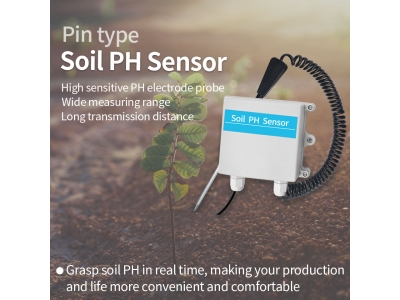Farming is an essential industry that provides us with food and sustains our way of life. With the global population continuing to rise, the demand for food is expected to increase significantly in the coming years. To meet this growing demand while ensuring sustainable agricultural practices, farmers are increasingly turning to innovative technologies. One such technology that is revolutionizing crop management is soil sensor technology. Soil sensors provide valuable insights into soil conditions, enabling precise and efficient farming practices. This article explores the significance of soil sensors in modern agriculture, their role in improving crop management, and the future implications of this transformative technology.

Understanding Soil Sensors
Soil sensors are electronic devices that are used to measure and monitor various parameters of the soil, such as moisture content, temperature, nutrient levels, and pH. These sensors are typically embedded in the ground at different depths and locations within a farm. They collect data on soil conditions and transmit it wirelessly to a central system for analysis and interpretation. Soil sensors can be categorized into different types based on the parameters they measure, including moisture sensors, temperature sensors, nutrient sensors, and pH sensors.
a. Moisture Sensors: Moisture sensors measure the water content in the soil, providing essential information about soil moisture levels. This data helps farmers determine when and how much water to irrigate, optimizing water usage and preventing over or under-watering.
b. Temperature Sensors: Temperature sensors monitor the soil temperature, which is crucial for determining optimal planting times and predicting plant growth rates. Different crops have specific temperature requirements for germination and growth, and temperature sensors help farmers create ideal conditions for their crops.
c. Nutrient Sensors: Nutrient sensors measure the concentration of essential nutrients in the soil, such as nitrogen, phosphorus, and potassium. This information allows farmers to apply fertilizers more precisely, reducing waste and minimizing environmental impact.
d. pH Sensors: pH sensors measure the acidity or alkalinity of the soil. Soil pH plays a critical role in nutrient availability and affects plant growth. pH sensors help farmers adjust soil pH levels to create optimal conditions for different crops.
Benefits of Soil Sensors in Crop Management
Soil sensors offer numerous benefits that revolutionize crop management and contribute to sustainable agriculture practices. Some key advantages include:
a. Precision Farming: Soil sensors enable precision farming by providing real-time data on soil conditions. This allows farmers to make informed decisions and take precise actions, such as adjusting irrigation, fertilizer application, and pest control measures. Precision farming optimizes resource utilization, reduces waste, and increases crop productivity.
b. Water Conservation: By accurately measuring soil moisture levels, soil sensors help farmers optimize irrigation practices. They provide insights into the actual water requirements of crops, preventing over-watering, which can lead to water wastage and environmental degradation. Water conservation is particularly crucial in regions facing water scarcity or drought conditions.
c. Improved Nutrient Management: Nutrient sensors help farmers monitor nutrient levels in the soil accurately. This enables targeted fertilizer application, ensuring that crops receive the necessary nutrients while minimizing excess usage. Improved nutrient management reduces fertilizer runoff, which can pollute water bodies, and lowers the overall environmental impact of agriculture.
d. Increased Crop Yield and Quality: By providing precise information about soil conditions, soil sensors help farmers create optimal growing environments for their crops. This leads to increased crop yields and improved crop quality. Farmers can adjust irrigation, nutrient applications, and other cultivation practices based on real-time data, maximizing the potential of their land.
e. Cost Savings: Soil sensors contribute to cost savings by optimizing resource utilization. Farmers can avoid unnecessary expenses on water, fertilizers, and other inputs by applying them only when and where needed. This reduces production costs and improves the profitability of farming operations.
f. Environmental Sustainability: The efficient use of resources facilitated by soil sensors promotes environmental sustainability. Reduced water usage, decreased fertilizer runoff, and minimized chemical applications contribute to the conservation of natural resources and the preservation of ecosystems.
Advancements in Soil Sensor Technology
Advancements in soil sensor technology have paved the way for more accurate, reliable, and user-friendly devices. Some notable advancements include:






